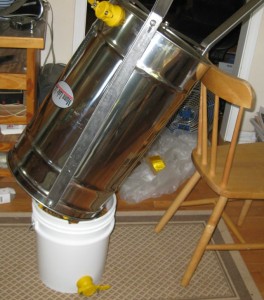The past few days I’ve noticed fewer bees at the hive entrance than a couple of weeks ago. I’m still a rank amateur at beekeeping so the explanations/fears that came to mind were somewhat exaggerated and untempered by experience: a) half the hive had swarmed; b) worse still, the hive had swarmed and the new queen bee had not returned from her mating flight and the hive was queenless; c) my obstinance against using chemicals had caught up with me and the hive was in collapse from disease, mites etc.; d) there was nothing wrong with the hive and although the temperature was still in the 90’s there was much less humidity and therefore less need for the bees to escape the internal hive heat by clustering the entrance, and they were all still around and industriously at work.
So this morning I gathered dry pine needles, lit the smoker and opened the hive and ….. everything seemed ok. The configuration from bottom up is two deep supers and one shallow super, which I added 7 weeks ago. All the supers hold 10 frames. The bottom super is the brood nest area and the deep super above it is where I harvest my honey. On 5/28/11 I harvested 3 frames, which produced about 1.1 gallons of honey, on 7/10/11 I harvested another 3 frames which produced almost 1.5 gallons of honey. Today I decided to remove another 3 frames. All 10 frames in the super held honey and I could have taken nine frames (my extractor handles 3 frames at a time, so the # of frames taken should be divisible by 3) since in north Georgia there are a lot of wildflowers which will still bloom and provide nectar for the bees. However, I do not sell my honey, so robbing just 3 frames together with my inventory from previous takings is more than enough for gifts to friends and for our own needs through next spring. And I want the bees to have adequate reserves going into winter so there will be less need for me to feed them sugared water.
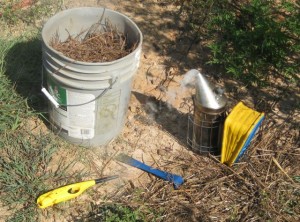
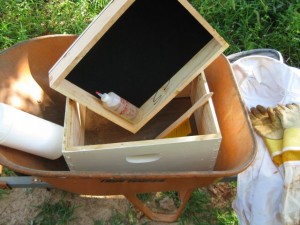
I was asked how I rob the honey. It is really quite simple. I trundle my wheelbarrow and equipment to the hive including a fume board, an extra deep super, a container of butyric acid and my bee brush. I open the hive and select the three heaviest most capped frames. The way it works is the bees add nectar to the honey cells and when sufficient moisture has evaporated from the cells, the bees cap the cells. Ideally, all the cells should be capped. When I first harvested honey earlier this year, about 30% of the cells were not capped and the honey was too fluid and tasted of nectar, which some of my friends liked, but the more knowledgeable bit their tongues. So today I was lucky and all the cells on the 6 sides of the 3 frames were honey cells and were capped.
I place the three frames in the extra super I brought along and place it on top of the open hive. I sprinkle the vile smelling butyric acid on the felt inner cover of the fume board and place the fume board on top of the upper super (the one containing the 3 frames). The fumes drive most of the bees from the upper super to the lower supers. I then pick up the super (containing the three frames) with the fume board on top, load them in the barrow and head for the kitchen. I stop a couple of times to encourage the remaining bees to depart with gentle upward sweeps with the bee brush. By the time I reach the house I have 3 honey laden frames and no bees.
The frames are individually placed on a piece of wood located above a medium filter inserted in the top of a 5 gallon pail. I use a bread knife or, more often, an uncapping scratcher to remove the capping layer on the honey cells. Because the temperature is high the wax is soft and the scratcher works effortlessly and efficiently. I then load the frames individually into the 3 frame hand crank extractor and give them a hard whirl. The centrifugal motion of the extractor flings the honey contents of the frames onto the sides of the extractor and the honey slides to the bottom. I then reverse the position of the frames, so their other side is facing outwards, and give them also a fast spin.

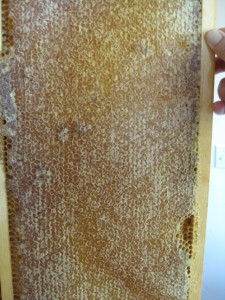
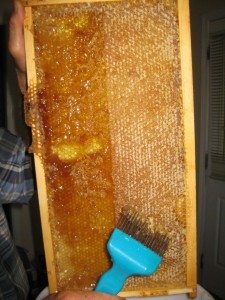
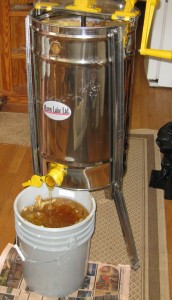
I return the 3 frames to the hive, place the wax remnants in a container in front of the hive, bottle the honey and clean and store the equipment. The bees readily reclaim their honey remnants and continue with their honey making. The procedures entail a lot of work for just 3 frames and without much more effort I could easily do 6 or 9 frames. Just like with making a loaf of whole wheat bread – a lot of work but a very satisfying result.
